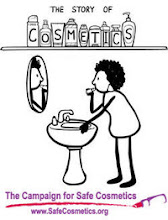I wash most of all of my flatware and glasses by hand. They are fragile and not dishwasher-safe. I switched to Mrs. Meyer's Clean Day products about a year ago. I also have her hand soap in the bathroom. Right after the one-two punch of the skincare and hair color info that I shared last week, I thought, OK... good. I got it down now.
No...not so fast.
One of the big hazards to be aware of in skincare, the category which dishwashing liquid and hand soaps also fall into because of frequent use and direct skin contact, are PEG's (PEG 40, 80, 100...there are lots of them) or anything ending in "-eth". These are suspect 'until proven clean' of being contaminated by 1,4-dioxane. 1,4-dioxane is not listed on any label. This known animal carcinogen and suspected human carcinogen is formed during the process called "ethoxylation" which changes harsher ingredients into a milder state, for example when lauryl is converted to laureth, by adding the petro-chemical ethylene oxide.
A consumer can identify products that may contain 1,4-dioxane by scanning ingredient lists for the common ingredients that may contain the impurity, identifiable by the prefix or designations of 'PEG,' '–eth–,' 'Polyethylene,' 'Polyethylene glycol' 'Polyoxyethylene,' or '–oxynol–' (FDA 2007).
The U.S. National Toxicology Program has concluded that 1,4-dioxane is 'reasonably anticipated to be a human carcinogen' based on numerous animal studies (NTP 2005). IARC classifies 1,4-dioxane as 'possibly carcinogenic to humans' (IARC 1999), and the U.S. Environmental Protection Agency (EPA) considers 1,4-dioxane a probable human carcinogen (EPA 2003). Exposures to this impurity are linked to tumors of the liver, gallbladder, nasal cavity, lung, skin, and breast (IARC 1999; NTP 2005). Presence of 1,4-dioxane in cosmetics is of special concern, since it can be absorbed through the skin in toxic amounts.
Also, be particularly wary of any "nano" technology or "nano" particles used...that is where ingredients are encapsulated in a special delivery system to go deeper into the cell. You need to do a real purity check on any of those because they could be mainlining toxic stuff right to the heart of your cells!
And so, there it was, big as life on my hand soap: sodium laureth sulfate. I rushed to http://www.cosmeticdatabase.com/ and entered in Mrs. Meyers and the parent company, Caldrea. Non-signers of the Compact for Cosmetic Safety with hazardous scores between 3-7. As you know from last week, I have a "safety first" blog and will not recommend any non-signer's products at all and only signer's products with hazard scores between "0" and "2". Therefore, 'nuf said about these two companies.
With stuff piling up in the sink, now what? I love this "sandwich" stage...I am surrounded by great teachers. I remembered my daughter had told me about Dr. Bronner's "magic" castile soaps, http://www.drbronner.com/
Lissa said you can use them for everything, in a pinch, even brushing your teeth! I remembered, too, that my grandmother had used castile soap. And so, I ran again to the hazard database. Dr. Bronner is a signer and his products score "1-2". Maybe I should write Michael Pollan to amend his Food Rules...to "Just eat what grandma did; just do what grandma did. Period." I have added these products into Our Little Green Book. They are a "go". I am going to go now, too, and wash up the pile in the sink!
If this post has you a little lost, read the three most recent posts under "Dressing Table Beauty Bites". Next week, I will have more news on hair color and will share a letter from a senator.
Subscribe to:
Post Comments (Atom)












Wow, this is good to know...we use Meyers at home.
ReplyDeleteI know. It has really helped me to remember that my skin eats a bigger meal every day than my mouth and to really check up on the brand! The website, www.cosmeticdatabase.com is a life saver!xoxox
ReplyDelete